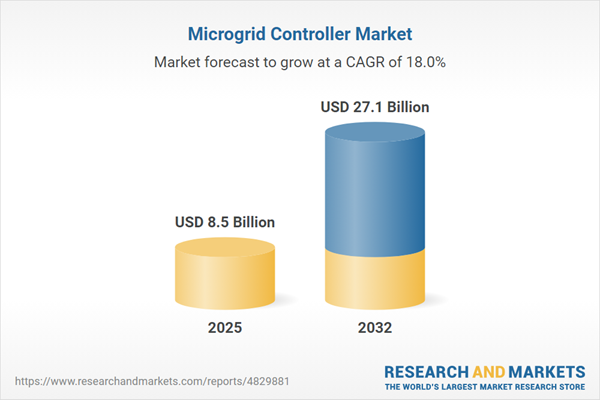Speak directly to the analyst to clarify any post sales queries you may have.
Microgrid controllers are rapidly redefining modern energy infrastructure, providing the intelligence and flexibility necessary for resilient, efficient, and decentralized power systems. As renewable integration accelerates and complexity within energy networks grows, senior decision-makers are prioritizing platforms that can optimize operations, ensure reliability, and support sustainability initiatives.
Market Snapshot: Microgrid Controller Market Size and Growth
The Microgrid Controller Market grew from USD 7.20 billion in 2024 to USD 8.50 billion in 2025. The market is expected to continue expanding at a CAGR of 18.01%, reaching USD 27.10 billion by 2032. This sustained growth reflects increasing investment in distributed energy resources, digitalized control systems, and strategies to strengthen operational resilience across varied sectors and regions.
Scope & Segmentation
This market research provides an in-depth analysis of microgrid controller adoption based on several critical segmentation parameters designed for senior leaders seeking actionable insights:
- Power Rating: Up to 100 kW systems prioritize simplified setup for small sites, 100 kW to 1 MW controllers serve modular mid-sized operations, and above 1 MW platforms target industrial and large commercial environments.
- Control Architecture: Centralized, decentralized, and hierarchical systems are compared to underline benefits for oversight, peer-to-peer management, and flexible coordination across distributed assets.
- Installation Type: Grid-tied controllers support active tariff management, hybrid installations enable optimal storage strategies, and islanded set-ups deliver independent energy autonomy.
- Communication Technology: Wired protocols such as Ethernet, Modbus, and serial links offer deterministic performance, while wireless options like cellular, LoRa, and WiFi support deployment flexibility.
- End Use: Analysis spans commercial and industrial fields (including agriculture, data centers, healthcare, manufacturing, and retail), military and government applications, remote/off-grid deployments, residential, and utility sectors.
- Regions: The report investigates trends across the Americas, including North America and Latin America; Europe, Middle East & Africa; and Asia-Pacific.
- Key Companies: Coverage includes ABB Ltd., Ameresco, Bloom Energy Corporation, CleanSpark Inc., Cummins Inc., Eaton Corporation PLC, ELM Companies, Emerson Electric Co., Encorp, Enel X S.r.l., Engie SA, ETAP by Operation Technology, Inc., General Electric Company, Go Electric Inc., Heila Technologies, Hitachi Limited, HOMER Energy LLC by UL LLC, Honeywell International Inc., Lockheed Martin Corporation, MAN Energy Solutions, Nidec Corporation, NR Electric Co., Ltd., Pareto Energy Ltd., Power Analytics Corporation, S&C Electric Company, Scale Microgrid Solutions LLC, Schneider Electric SE, Schweitzer Engineering Laboratories, Inc., Siemens AG, Spirae,LLC, and Tesla, Inc.
Key Takeaways: Evolving Capabilities and Strategic Shifts
- Advanced microgrid controllers boost system resilience by balancing distributed energy resources with real-time analytics and predictive intelligence, especially as energy grids evolve beyond traditional models.
- Integration of AI, machine learning, and digital twin technologies is driving smarter forecasting, asset optimization, and scenario-based risk mitigation for microgrid operations.
- Open standards and interoperability are reducing vendor dependency and streamlining integration with emerging hardware and software components.
- Deployment flexibility is enhanced through modular architectures and tailored solutions addressing the diverse requirements of projects from remote rural sites to complex urban networks.
- Granular visibility into energy flows empowers operators to make data-driven decisions, improving maintenance scheduling and resource allocation.
Tariff Impact: Reshaping Procurement and Supply Strategies
Tariff introductions on imported electrical components in 2025 have created cost pressures for manufacturers and integrators in the microgrid controller space. The resulting drive for onshoring, alternative component sourcing, and close vendor partnerships has spurred supply chain adjustments and localized production expansion—while presenting operational challenges in workforce readiness and quality assurance. Strategic collaborations now help buffer against future policy changes and stimulate sustainability in innovation pipelines.
Methodology & Data Sources
This analysis leverages a rigorous methodology: extensive secondary research, expert interviews, quantitative surveys, and structured validation. Findings are cross-verified using panel reviews, sensitivity assessments, and scenario analyses to ensure data integrity and relevance for informed strategic planning.
Why This Report Matters
- Enable senior decision-makers to benchmark controller architectures, technology adoption, and supplier strategies for resilience and flexibility.
- Identify regional and sector-specific opportunities, aligning developments in digitalization and security with operational priorities.
- Support actionable investment and procurement strategies by mapping emerging risks and opportunities across global supply chains and regulatory frameworks.
Conclusion
Microgrid controllers stand at the center of distributed energy innovation, driving operational resilience and supporting the transition to sustainable, adaptive power networks. Strategic adoption of these systems will be crucial for organizations looking to stay agile in evolving energy markets.
Additional Product Information:
- Purchase of this report includes 1 year online access with quarterly updates.
- This report can be updated on request. Please contact our Customer Experience team using the Ask a Question widget on our website.
Table of Contents
3. Executive Summary
4. Market Overview
7. Cumulative Impact of Artificial Intelligence 2025
Companies Mentioned
The companies profiled in this Microgrid Controller market report include:- ABB Ltd.
- Ameresco
- Bloom Energy Corporation
- CleanSpark Inc.
- Cummins Inc.
- Eaton Corporation PLC
- ELM Companies
- Emerson Electric Co.
- Encorp
- Enel X S.r.l.
- Engie SA
- ETAP by Operation Technology, Inc.
- General Electric Company
- Go Electric Inc.
- Heila Technologies
- Hitachi Limited
- HOMER Energy LLC by UL LLC
- Honeywell International Inc.
- Lockheed Martin Corporation
- MAN Energy Solutions
- Nidec Corporation
- NR Electric Co., Ltd.
- Pareto Energy Ltd.
- Power Analytics Corporation
- S&C Electric Company
- Scale Microgrid Solutions LLC
- Schneider Electric SE
- Schweitzer Engineering Laboratories, Inc.
- Siemens AG
- Spirae,LLC
- Tesla, Inc.
Table Information
| Report Attribute | Details |
|---|---|
| No. of Pages | 195 |
| Published | November 2025 |
| Forecast Period | 2025 - 2032 |
| Estimated Market Value ( USD | $ 8.5 Billion |
| Forecasted Market Value ( USD | $ 27.1 Billion |
| Compound Annual Growth Rate | 18.0% |
| Regions Covered | Global |
| No. of Companies Mentioned | 32 |









